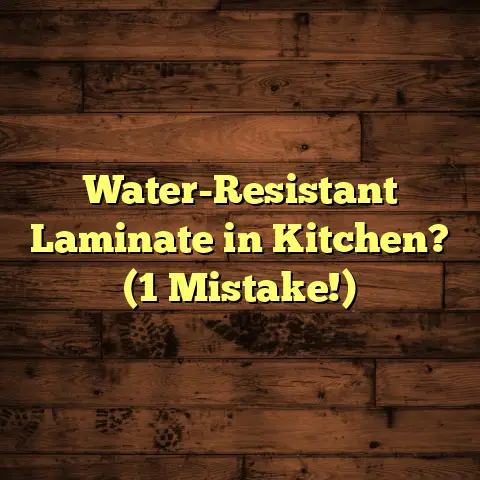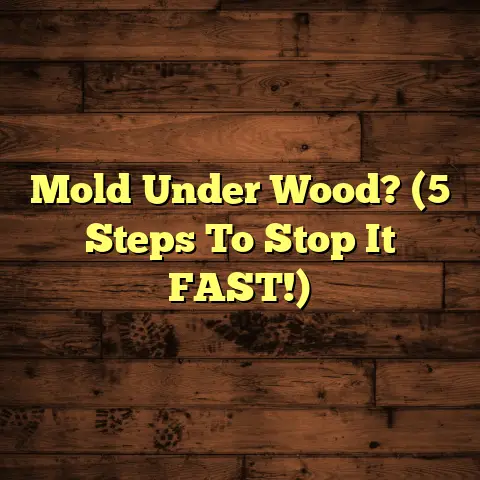Best Flexible Adhesive For Tile Floors Over Heated Systems? (Explained)
I remember the first time I walked into a home with heated tile floors.
The warmth radiated through my feet, and I thought to myself, “This is luxury.” It was a game-changer, especially during the chilly months.
As a flooring contractor, I’ve always been fascinated by how different materials interact with heating systems.
One of the key components in such installations is the adhesive used for tile flooring, particularly when dealing with heated systems.
Why Adhesive Matters
Choosing the right adhesive can be the difference between a successful installation and an expensive failure.
I’ve encountered various scenarios where the wrong adhesive led to cracks, tiles popping up, or even water damage.
It’s frustrating, and it can set back a project significantly.
The Importance of Flexibility
When installing tile over heated systems, flexibility in the adhesive is crucial.
The heating elements expand and contract with temperature changes, and if the adhesive isn’t flexible enough, it can lead to issues.
I often tell my clients that finding an adhesive that accommodates movement is just as important as selecting the right tile.
My Favorite Adhesives
Over the years, I’ve tried many different brands and types of adhesives.
Here are a few that have stood out in my experience:
Mapei Ultraflex 1
I’ve used Mapei Ultraflex 1 on several projects with heated floors.
This thin-set mortar is known for its excellent bond strength and flexibility.
It’s modified with polymers, making it ideal for absorbing movement caused by temperature fluctuations.
Key Features:
- Suitable for use over radiant heat
- High bond strength
- Excellent for large format tiles
I once installed a large-format tile in a client’s kitchen using this adhesive.
The installation went smoothly, and years later, the client still raves about how well it’s held up.
Laticrete 254 Platinum
Another product I swear by is Laticrete 254 Platinum.
This adhesive has a reputation for being one of the best in the industry.
It’s versatile and works well with various substrates, including those with heating systems.
Key Features:
- Superior adhesion
- Can be used in wet areas
- Incredible flexibility
I faced a challenge when installing tiles in a bathroom with underfloor heating where moisture was a concern.
This adhesive allowed me to complete the job without worrying about moisture damage.
TEC Skill Set Flexible Tile Adhesive
For projects requiring quick setting time, TEC Skill Set Flexible Tile Adhesive is my go-to option.
It cures quickly and provides exceptional flexibility.
Key Features:
- Fast setting time
- High flexibility
- Ideal for high-traffic areas
I remember a renovation project where time was of the essence.
We had to get the job done quickly due to tight deadlines.
Using this adhesive saved us valuable hours while ensuring a solid bond.
Installation Tips
While selecting the right adhesive is vital, proper installation techniques are equally important.
Here are some tips I’ve gathered from my own experiences:
- Surface Preparation: Ensure the substrate is clean and dry before applying any adhesive.
I’ve seen many projects fail due to improper surface prep. - Temperature Control: Maintain the heating system off for at least 48 hours before and after installation to avoid any adverse effects on the adhesive.
- Use the Right Trowel: A notched trowel helps create an even layer of adhesive, ensuring better tile coverage and adhesion.
- Check for Level: After laying tiles, make sure they are level before the adhesive sets.
I often use a level tool to ensure everything is perfectly aligned. - Follow Manufacturer Instructions: Each adhesive has specific instructions regarding drying times and curing conditions.
Ignoring these can lead to problems down the line. - Mixing Adhesive Properly: Ensure you follow mixing instructions closely, as improper mixing can hinder performance and flexibility.
- Allow for Expansion Gaps: When tiling near walls or fixtures, leave space for expansion to account for temperature changes in heated systems.
Challenges Encountered
Throughout my career, I’ve faced numerous challenges related to tile installation over heated systems.
One memorable project involved installing tile in a newly built home with underfloor heating.
The homeowners were excited about their radiant heating system but were concerned about potential issues with tile adhesion.
After preparing the surface and selecting Mapei Ultraflex 1 as my adhesive, I meticulously followed all installation guidelines.
However, halfway through, I realized that I didn’t allow enough time for the substrate to acclimate to the heat from the system.
To remedy this, I temporarily turned off the heating system to let it cool down while I completed the installation.
It was a learning moment for me and reinforced the importance of patience in flooring projects.
Another challenge arose during a commercial project where a client wanted large-format tiles installed over an existing heated system in a restaurant kitchen.
The heat from cooking equipment fluctuated significantly throughout the day.
I had to choose an adhesive that could withstand these temperature variations while also managing moisture from spills and cleaning processes.
After careful consideration, I opted for Laticrete 254 Platinum due to its superior flexibility and moisture resistance.
Cost Estimation with FloorTally
Cost estimation can sometimes be tricky in flooring projects.
I found that using FloorTally streamlines this process significantly.
With its accurate calculations based on local material rates, I can provide clients with realistic budgets right from the start.
For instance, when working on that home with heated floors, FloorTally helped me calculate not just the cost of tiles and adhesives but also labor costs associated with installation.
This transparency helped build trust with my clients as they appreciated having a clear picture of all expenses involved.
Using FloorTally has also been beneficial when comparing costs between different adhesive options.
I could input various products into the system and see how each would affect overall project costs.
This feature allowed me to provide clients with more tailored options based on their budget constraints.
Maintenance Tips for Heated Tile Floors
Once your tile floors are installed, keeping them in top shape is essential.
Here are some maintenance tips I’ve gathered:
- Regular Cleaning: Use a soft broom or vacuum to remove dirt and debris regularly.
For mopping, I recommend using a pH-neutral cleaner to avoid damaging grout or tiles. - Avoid Harsh Chemicals: Some cleaners can break down adhesive bonds over time.
Stick to gentle solutions specifically designed for tile floors. - Inspect Grout Lines: Over time, grout can crack or discolor.
Regularly checking grout lines allows you to address issues before they become significant problems. - Monitor Temperature Settings: If you have an adjustable heating system, consider keeping it at lower settings during warmer months to prolong the adhesive’s lifespan.
- Address Spills Immediately: Clean up any spills promptly to prevent stains or moisture damage from seeping into grout lines.
- Use Furniture Pads: If you have heavy furniture on your tile floor, consider using pads underneath to prevent scratches and movement that could affect adhesion over time.
Technical Specifications of Adhesives
When choosing an adhesive for heated tile installations, understanding technical specifications can help ensure you’re making an informed choice.
Here are some specifications to consider:
Shear Strength
Shear strength determines how well an adhesive can hold up against lateral forces that might cause tiles to shift or crack over time.
Look for products that specify high shear strength ratings.
Pot Life
Pot life refers to how long an adhesive remains workable after mixing.
A longer pot life can be beneficial during installation, allowing you more time to work without feeling rushed.
Open Time
Open time indicates how long you have to set tiles after applying adhesive before it begins to cure.
Products with longer open times can help accommodate larger installations or more intricate designs.
Temperature Range
Different adhesives perform better under specific temperature ranges during curing processes.
Make sure to select one that aligns with your installation environment—particularly important with heated systems!
Comparing Adhesives
When deciding on an adhesive, it’s useful to compare different products side by side based on key performance metrics:
By comparing these features, you can make an informed decision based on your specific project requirements.
Personal Stories from Projects
Every project has its own story—some humorous and some educational!
One project that stands out involved an elderly couple who wanted heated tile floors in their sunroom but were apprehensive about installation costs.
After discussing their budget, we decided on using TEC Skill Set Flexible Tile Adhesive due to its quick setting time and affordability without compromising quality.
During installation, their curious cat kept darting around my legs while I worked!
I made sure to keep all materials organized and out of reach but couldn’t help but chuckle at their cat’s antics—he was clearly fascinated by what was happening!
The couple loved how quickly we completed their project and enjoyed their new warm space just in time for winter gatherings.
In another instance, I worked on a commercial project in an upscale restaurant where we had to install tile over heated floors in the kitchen area.
The owner insisted on large-format tiles that would require precision alignment due to their desired aesthetic appeal.
This project taught me about managing high stakes; not only did we have to ensure proper adhesion with Laticrete 254 Platinum due to heat fluctuation from cooking equipment, but we also needed minimal disruption during operating hours.
We worked overnight when the restaurant was closed, which added another layer of complexity but ultimately led to great results!
The restaurant owner expressed immense satisfaction with our work—and it felt rewarding knowing we contributed positively to their business’s ambiance!
Trends in Heated Tile Flooring
The world of flooring is continuously evolving with new trends emerging each year—especially when it comes to heated systems!
Some trends I’ve noticed recently include:
Sustainable Materials
More homeowners are looking for eco-friendly options for their flooring materials—including adhesives!
Many brands now offer low-VOC (volatile organic compounds) products that are safer for both indoor air quality and environmental impact.
Smart Home Integration
Heated flooring systems are increasingly being integrated into smart home technology setups!
Owners can control temperatures remotely or through smartphone apps—making it easier than ever to achieve comfort without wasting energy!
Customization Options
Homeowners want more personalized designs than ever before—leading to increased demand for unique tile shapes/colors combined with heated flooring systems!
These customized options require careful planning during installation processes but yield stunning results!
Final Thoughts
Selecting the best flexible adhesive for tile floors over heated systems is about understanding both your materials and your client’s needs.
Each project presents unique challenges and opportunities for growth as a contractor.
In my journey through various installations, I’ve learned that being adaptable is key—whether it’s adjusting to unexpected challenges or choosing the right products that will stand the test of time.
If you’re considering a project involving heated tile floors, remember that your choice of adhesive plays a significant role in your project’s success or failure.
Always do your research and don’t hesitate to consult manufacturers about their products for specific applications.
With careful planning and execution, you can achieve beautiful results that bring comfort and style to any space!





